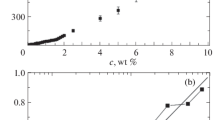Abstract
The dependences of the thermally stimulated current in metal-polymer-metal structures with electrodes prepared from different materials are investigated. Poly(diphenylenephthalide) films are used as a polymer. The possible contribution of the injection component to the thermally stimulated current spectrum is considered. The injection conditions are changed by replacing the electrode material. It is established that the change in the material does not lead to a change in a qualitative behavior of the temperature dependence of the current. However, the use of copper as the electrode material gives rise to an additional injection component in the thermally stimulated current spectrum and (under specific conditions) electronic switching of the sample from an insulating state to a highly conducting state. The charge is injected into deep localized electronic states that lie near the middle of the band gap of the polymer.
Similar content being viewed by others
References
R. H. Friend, R. W. Gymer, A. B. Holmes, J. H. Burroughes, R. N. Marks, C. Taliani, D. D. C. Bradley, D. A. Dos Santos, J. L. Bredas, M. Lögdlund, and W. R. Salaneck, Nature (London) 397, 121 (1999).
Semiconducting Polymers: Chemistry, Physics, and Engineering, Ed. by G. Hadzüoannou and P. F. van Hutten (Wiley, Weinheim, Germany, 2000).
Yu. A. Gorokhovatskiĭ and G. A. Bordovskiĭ, Thermally Activation Current Spectroscopy of High-Resistance Semiconductors and Dielectrics (Nauka, Moscow, 1991) [in Russian].
P. G. Kasherininov and D. G. Matyukhin, Fiz. Tekh. Poluprovodn. (St. Petersburg) 32(6), 668 (1998) [Semiconductors 32 (6), 599 (1998)].
V. I. Arkhipov, E. V. Emelianova, R. Schmechel, and H. von Seggern, J. Non-Cryst. Solids 338–340, 626 (2004).
V. R. Nikitenko, A. Kadashchuk, R. Schmechel, and H. von Seggern, J. Appl. Phys. 98, 103702 (2005).
S. N. Salazkin, Vysokomol. Soedin., Ser. B 46, 1244 (2004) [Polym. Sci., Ser. B 46, 203 (2004)].
J. R. Rasmusson, Th. Kugler, R. Erlandsson, A. Lachinov, and W. R. Salaneck, Synth. Met. 76, 195 (1996).
A. F. Ponomarev, V. A. Krasilnikov, M. Vasiliev, and A. N. Lachinov, Zh. Tekh. Fiz. 73(11), 137 (2003) [Tech. Phys. 48 (11), 1493 (2003)].
A. N. Lachinov, A. Yu. Zherebov, and M. G. Zolotukhin, Synth. Met. 59, 377 (1993).
A. Milns, Deep Impurities in Semiconductors (Wiley, New York, 1973; Mir, Moscow, 1977).
R. H. Bube, Photoconductivity of Solids (Wiley, New York, 1960; Inostrannaya Literatura, Moscow, 1962).
V. Kh. Il’yasov, A. N. Lachinov, A. V. Moshelev, and A. F. Ponomarev, Fiz. Tverd. Tela (St. Petersburg) 50(3), 547 (2008) [Phys. Solid State 50 (3), 568 (2008)].
C. R. Wu, N. Johansson, A. N. Lachinov, S. Stafstrom, T. Kugler, J. Rasmusson, and W. R. Salaneck, Synth. Met. 67, 125 (1994).
Handbook of Physical Quantities, Ed. by I. S. Grigoriev and E. Z. Meilikhov (Énergoatomizdat, Moscow, 1991; CRC Press, Boca Raton, FL, United States, 1997).
K. Kao and W. Hwang, Electrical Transport in Solids (Pergamon, Oxford, 1981; Mir, Moscow, 1984), Part. 1.
R. B. Salikhov, A. N. Lachinov, and R. G. Rakhmeev, Fiz. Tekh. Poluprovodn. (St. Petersburg) 41(10), 1182 (2007) [Semiconductors 41 (10), 1165 (2007)].
C. B. Duke and T. J. Fabish, Phys. Rev. Lett. 37, 1075 (1976).
A. N. Lachinov, V. M. Kornilov, T. G. Zagurenko, and A. Yu. Zherebov, Zh. Éksp. Teor. Fiz. 129(4), 728 (2006) [JETP 102) (4), 640 (2006)].
Author information
Authors and Affiliations
Corresponding author
Additional information
Original Russian Text © A.N. Lachinov, A.V. Moshelev, A.F. Ponomarev, 2009, published in Fizika Tverdogo Tela, 2009, Vol. 51, No. 3, pp. 590–595.
Rights and permissions
About this article
Cite this article
Lachinov, A.N., Moshelev, A.V. & Ponomarev, A.F. Influence of the electrode material in a metal-polymer-metal structure on the temperature dependence of the thermally stimulated current. Phys. Solid State 51, 626–631 (2009). https://doi.org/10.1134/S1063783409030317
Received:
Accepted:
Published:
Issue Date:
DOI: https://doi.org/10.1134/S1063783409030317




